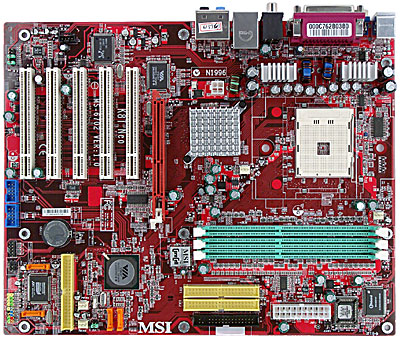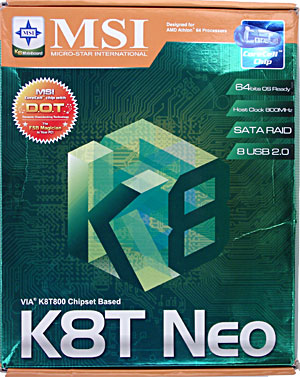MSI K8T Neo-FIS2R (VIA K8T800) Mainboard
|
MSI has only one VIA K8T800 based model so far, a top version of the future
family. Probably, other, cheaper (less functional and poorer equipped)
boards will appear when the Athlon 64 gets cheaper. This product does match
the niche it's positioned for and sells at a relatively low price.

The layout looks traditional: it might be difficult to hook up cables
to the connectors near the left edge, the SATA/IDE RAID are behind the
PCI slots, while the CD-In is in front of them; also, the cables and connectors
around the memory modules may lock access to them. It's not difficult to
reach the only jumper when the board is already installed. Its description
is provided on the PCB.
The 2-phase switching voltage regulator incorporates 8 capacitors of
1500 uF and 4 of 820 uF (MSI is the only company that installs heatsinks
on hot unipolar MOS transistors in the circuit of this regulator). There
are also voltage regulators of the AGP bus (1 capacitors of 1000 uF) and
of the memory (2 of 1000 uF). As expected, this top model has no components
which would be provided space for but not installed. The board measures
305x245 mm (wide ATX, 9 fastening screws, all edges fixed). System monitoring
is supported by Winbond W83697HF chip. It controls:
-
processor, battery voltage, +-5, +-12 V and +5 V Standby;
-
rotation speed of 2 fans;
-
temperatures of the processor (built-in sensor) and the board (built-in
sensor).
Ports & connectors onboard
-
CPU socket (Socket 754);
-
3 slots for DDR SDRAM DIMM (2 GB at most, it's recommended to use DIMM1
and DIMM2, 3 DDR400 modules are supported but only from the recommended
list);
-
AGP slot (with a rentention clip);
-
5 PCI slots;
-
Standard power supply connectors (ATX, 4pin for 12V);
-
FDD;
-
3 IDE (Parallel ATA) - 2 on chipset,1at the expense of the additional controller;
-
4 SATA (Serial ATA) - 2 on chipset, 2 at the expense of the additional
controller;
-
2 Connectors for brackets of 2 USB 2.0 ports;
-
Connector for audio-out from CD/DVD drive;
-
Case Open sensor;
-
Connector for IrDA devices;
-
POST controller connector (D-Bracket2);
-
Connectors for a bracket with additional audio-outs;
-
4 connectors for fans (2 with rotation control).
Rear panel (left to right, units)

-
PS/2 mouse and keyboard;
-
1 LPT, 1 COM, 6-pin (standard) and 4-pin (mini-FireWire) FireWire;
-
2 USB (2.0) and S/PDIF-Out (Coaxial);
-
2 USB (2.0) & 1 RJ-45 (Gigabit Ethernet);
-
5 audio ports (Mic-In, Line-In, Front, Rear, Center/Sub) and S/PDIF-Out
(TosLink).
On the back are connectors of all interfaces integrated, - this is the
most advanced combination which also includes dated LPT and COM interfaces.
Accessories

-
Package of the standard design;
-
Documentation: user manual, installation guide for IDE/SATA RAID (in English);
-
Cables: 2 Serial ATA (with power supply adapters), ATA66/100/133 and FDD
(both wide cables screened);
-
D-Bracket2 (2 USB (2.0) ports and 4 boot diagnostics LEDs);
-
I/O Shield;
-
Diskette with drivers for IDE/SATA RAID;
-
CD with:
-
drivers;
-
Adobe Acrobat Reader;
-
VNC;
-
3Deep;
-
DirectX 9.0a;
-
PC-cillin 2002;
-
X-setup;
-
MSI CoreCenter;
-
MSI DMI Browser;
-
MSI FuzzyLogic;
-
MSI GoodMem;
-
MSI InfoView;
-
MSI i-Speeder;
-
MSI LiveUpdate;
-
MSI LockBox;
-
MSI PCAlert;
-
MSI PWKeeper;
-
MSI SecureDoc;
-
MSI SmartKey;
-
MSI WMIinfo.
Integrated controllers
-
audio controller based on the Avance Logic ALC655 AC'97 codec; 5.1 audio
system supported, front audio I/Os and S/PDIF connector provided;
-
network controller based on the Realtek RTL8110S-32, 10/100/1000 Mbit/s
(Gigabit Ethernet);
-
FireWire on VIA VT6307 chip, 2 ports supported;
-
IDE/SATA RAID on Promise PDC20378 chip, RAID 0, 1 and 0+1, 2 SATA and 1
PATA.
The integrated audio quality was estimated at 16 bits, 44 kHz with the RightMark
Audio Analyzer 5.1 and Terratec DMX 6fire audio card:
| Frequency
response (40 Hz to 15 kHz), dB: |
+0.11, -1.09 |
Average |
| Noise
level, dB (A): |
-84.4 |
Good |
| Dynamic
range, dB (A): |
83.7 |
Good |
| THD,
%: |
0.042 |
Good |
| Intermodulation
distortions, %: |
0.064 |
Good |
| Channel
crosstalk, dB: |
-79.2 |
Very good |
General performance: Good (in
detail).
Technologies
-
Core Center (controls system parameters, allows for manual overclocking
from Windows, enables/disables Cool'n'Quiet etc., realizes functions integrated
in the MSI CoreCell chip);
-
D.O.T. (automatically increases the FSB/CPU clock speed at the heavy loads
on CPU and slows down it in the idle mode);
-
D-Bracket (POST controller reports about problems with 4 LEDs on D-Bracket2);
-
LiveUpdate (automatic update of drivers/BIOS via the Internet).
Settings
| jumpers and switches |
CMOS clear jumper |
|
| BIOS based on AMI 3.31a |
Setup of memory timings |
+ |
CAS Latency, Bank Interleaving, Burst Length, TRCD,
TRAS, TRP |
| Setup of memory frequency |
+ |
100, 133, 150, 166, 200 MHz |
| HT bus adjustment |
+ |
LDT Bus Frequency, Downstream LDT Bus Width, Upstream
LDT Bus Width |
| Setup of AGP bus |
- |
|
| Setup of PCI bus |
- |
|
| AGP/PCI frequency setup |
- |
|
| PCI IRQ manual assignment |
+ |
|
| FSB frequency setup |
+ |
190-280 MHz in 1MHz steps |
| CPU clock ratio |
- |
|
| CPU voltage control |
+ |
Auto, +3,3%, +5%, +6,6%, +8%, +10%, +11%, +15% |
| DIMM voltage control |
+ |
Auto, 2.55-2.85 V in 0.05V steps |
| NB voltage control |
- |
|
| AGP voltage control |
+ |
Auto, 1.55-1.85V in 0.05V steps |
We used the BIOS 1.0 as the latest available version.
Performance
According to the preliminary tests this model can be considered the best,
though its scores hardly differ from those of other VIA K8T800 based boards
(less than 2%).
| Benchmark |
ASUS K8V Deluxe |
Albatron K8X800 Pro II |
MSI K8T Neo-FIS2R |
| Memory read speed (CacheBurst32), MB/s |
2874 |
2927 |
2909 |
| 7-Zip archiving, min:sec |
6:59 |
6:53 |
6:54 |
| Return to Castle Wolfenstein (Normal@1024x768x32), fps |
215 |
217 |
219 |
Write a comment below. No registration needed!
|
|
 |
|
|
|



